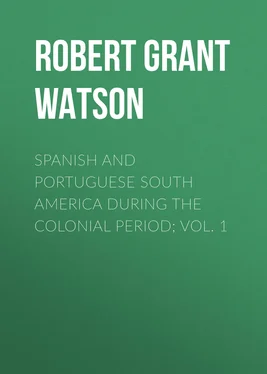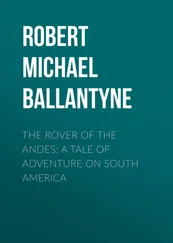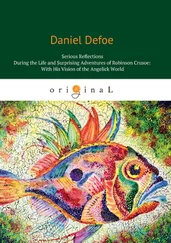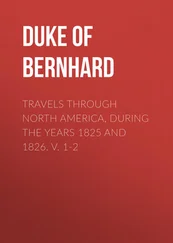Robert Grant Watson - Spanish and Portuguese South America during the Colonial Period; Vol. 1
Здесь есть возможность читать онлайн «Robert Grant Watson - Spanish and Portuguese South America during the Colonial Period; Vol. 1» — ознакомительный отрывок электронной книги совершенно бесплатно, а после прочтения отрывка купить полную версию. В некоторых случаях можно слушать аудио, скачать через торрент в формате fb2 и присутствует краткое содержание. Жанр: foreign_prose, История, foreign_edu, foreign_antique, на английском языке. Описание произведения, (предисловие) а так же отзывы посетителей доступны на портале библиотеки ЛибКат.
- Название:Spanish and Portuguese South America during the Colonial Period; Vol. 1
- Автор:
- Жанр:
- Год:неизвестен
- ISBN:нет данных
- Рейтинг книги:5 / 5. Голосов: 1
-
Избранное:Добавить в избранное
- Отзывы:
-
Ваша оценка:
- 100
- 1
- 2
- 3
- 4
- 5
Spanish and Portuguese South America during the Colonial Period; Vol. 1: краткое содержание, описание и аннотация
Предлагаем к чтению аннотацию, описание, краткое содержание или предисловие (зависит от того, что написал сам автор книги «Spanish and Portuguese South America during the Colonial Period; Vol. 1»). Если вы не нашли необходимую информацию о книге — напишите в комментариях, мы постараемся отыскать её.
Spanish and Portuguese South America during the Colonial Period; Vol. 1 — читать онлайн ознакомительный отрывок
Ниже представлен текст книги, разбитый по страницам. Система сохранения места последней прочитанной страницы, позволяет с удобством читать онлайн бесплатно книгу «Spanish and Portuguese South America during the Colonial Period; Vol. 1», без необходимости каждый раз заново искать на чём Вы остановились. Поставьте закладку, и сможете в любой момент перейти на страницу, на которой закончили чтение.
Интервал:
Закладка:
Still imagining the coast of Paria to be an island, the admiral left this lovely spot and again set sail, coasting to the westward in search for an outlet to the north. He found the water, however, growing shallower and fresher, so that he could not venture to proceed any further with his own ship. He therefore came to anchor, and sent forward a caravel to ascertain whether there was an outlet to the ocean. On the following day he learned, on its return, that there was an inner gulf beyond, which contained the mouths of four great rivers, the waters of which sweetened the neighbouring sea. As it was impossible to proceed further westward, he had no alternative but to retrace his way and seek an exit by “the mouth of the Dragon.” Although he would gladly have remained to explore this opulent coast, he was compelled, as well by the condition of his health as by the scarcity of sea-stores in his ships, to hasten his departure for Hispaniola .
The admiral, therefore, on the 11th of August, set sail eastwards, and was borne along swiftly by the currents. On the 13th, he anchored near to the strait; and on the following day, towards noon, the ships approached the Boca del Drago . The mouth of this formidable ocean-pass is about five leagues wide; but there are two islands lying between its extremities. The immense body of fresh water which flows through the gulf in the rainy season, meeting the incoming waves, causes a terrific commotion extremely dangerous to ships; and this was the first occasion on which vessels were to go through it. The great navigator had neither chart nor pilot to guide him; but fortunately no sunken rock obstructed his way, and the current of fresh water prevailing over the incoming waves carried him safely through. 1 1 The scene, well-deserving to be painted, might be described in the following lines:— “As rolls the river into ocean, In sable torrent wildly streaming; As the sea-tide’s opposing motion, In azure column proudly gleaming, Beats back the current many a rood In curling foam and mingling flood; Through sparkling spray, in thundering clash, The lightnings of the waters flash In awful whiteness o’er the shore, That shines and shakes beneath the roar.” The Giaour.
Columbus now shaped his course to the westward, along the outer coast of Paria , which he still supposed to be an island; and he was borne still further unconsciously on the same course (whilst he lay to at night in order to avoid running on rocks and shoals) by the Gulf Stream which sets across the Caribbean Sea. It took some time for him, with all his experience, to realise the fact that this great body of fresh water, brought by the rivers to the ocean, could not be the outcome of mere islands, but must proceed from the Terra Firma which was the object of his search. On leaving the coast of Paria , the navigator saw to the north-east, at some distance, in succession, the islands of Tobago and Granada , which form part of South America; but here we must for the present take leave of the great sea-king; 2 2 “Valiant sea-captains! Great sea-kings! And thou, Columbus! my hero! greatest sea-king of all!” Carlyle.
for the limits of this work merely include the continent of South America and the islands immediately belonging to it. As the minute study of American geography does not form part of the education of every one, it may be proper to remark that the geographical limits of South America are perfectly distinct from those of the various countries forming Central America, as well as from the islands of the Spanish Main.
The next Spanish navigator who appeared in these seas was the celebrated Alonzo de Ojeda, who had accompanied Columbus in his second voyage, being then but twenty-one years of age. Through the influence of a cousin of his own name, a Dominican friar, he had obtained from Bishop Fonseca a commission, authorising him to fit out an armament, and to proceed on a voyage of discovery, provided that he should not visit any territories belonging to Portugal, nor any lands discovered for Spain before 1495. It was stipulated that a certain proportion of his profits should be reserved for the Crown.
With this license in his pocket, Ojeda had now to find the means of turning it to account. He had a high reputation for courage and conduct; but he was destitute of wealth. This element, however, was supplied by some merchants of Seville, who had so much faith in him that they believed he would soon find the means of enriching them as well as himself. With their assistance he was soon enabled to equip a squadron of four vessels, with which he set sail from St. Mary’s, near Cadiz. He had on board several seamen who had accompanied Columbus to Paria , for which coast Ojeda shaped his course. But the man on whom he chiefly relied was Juan de la Cosa, who had sailed with Columbus on his second voyage, and who was one of the ablest mariners of the day. Ojeda had likewise with him Amerigo Vespucci, a Florentine merchant, then established at Seville, whose fame arose, not from any part which he took in this expedition, but from his published narratives and from his subsequent voyages to another part of the South American continent.
Ojeda and his companions, who sailed from St. Mary’s on the 20th of May 1499, were guided by the charts which the admiral had sent home. Touching at the Canaries , they followed the route of Columbus, and at the end of twenty-four days reached the New World, about two hundred leagues further south than the point where the admiral had landed, being somewhat near Surinam . Thence Ojeda coasted northwards, passing the mouths of many rivers, more especially the Orinoco . The first natives they beheld were at Trinidad , the people of which are described in the letters of Vespucci. 3 3 Viaggi de Amerigo Vespucci.
After touching at several points of Trinidad and of the Gulf of Paria , Ojeda passed through the Boca del Drago , and then steered his course to the westward along the coast of Paria , until he arrived at Cumana or the Gulf of Pearls. Thence he stood for the opposite island of Margarita , which had been discovered by Columbus. This island and others adjacent were now explored; after which Ojeda returned to the mainland. At Maracapana he careened his vessels and built a small brigantine. The natives were friendly, and brought him abundance of provisions, in return for which they besought Ojeda to assist them in an expedition against the inhabitants of an island, who were wont to carry off their people to be eaten.
Such a request was greatly to the mind of the enterprising Castilian, and after sailing for seven days, he arrived at what are supposed to be the Caribbee Islands, one of which was pointed out by his guides as the abode of their foes. His landing was at first stoutly opposed; but on hearing the sound of his guns, the savages fled in terror, whilst Ojeda and his men pursued them to the shore. The Carib warriors, however, rallied and courageously fought for a long time, but they were at length driven to the woods, leaving many killed and wounded. The fight was renewed on the succeeding day with the same result, after which the Spaniards set out on their return to the mainland, where Ojeda anchored for three weeks, to give his men time to recover from their wounds.
When his crew were again fit for the sea, Ojeda made sail and touched at the island of Curacoa . Entering a vast gulf, he beheld on the eastern side a village of strange construction. It consisted of a few large houses, shaped like bells, and built on piles driven into the bottom of the shallow lake. The houses were provided with drawbridges, and the communication was carried on by means of canoes. In this slight resemblance to the Queen of the Adriatic originated the name of Venezuela , or Little Venice. The native name was Coquibacoa . At sight of the ships the natives fled in terror, as did the rowers of a squadron of canoes which entered the harbour from the sea. They soon returned, however, bringing a peace-offering of sixteen young girls. The peace was of short duration; at a signal from some old women the Indians discharged a flight of arrows, and the girls plunged into the sea. But Ojeda was in no way taken aback. Manning his boats, he dashed amongst the canoes, sinking some of them, and killing and wounding a number of Indians, whilst the remainder took to flight.
Читать дальшеИнтервал:
Закладка:
Похожие книги на «Spanish and Portuguese South America during the Colonial Period; Vol. 1»
Представляем Вашему вниманию похожие книги на «Spanish and Portuguese South America during the Colonial Period; Vol. 1» списком для выбора. Мы отобрали схожую по названию и смыслу литературу в надежде предоставить читателям больше вариантов отыскать новые, интересные, ещё непрочитанные произведения.
Обсуждение, отзывы о книге «Spanish and Portuguese South America during the Colonial Period; Vol. 1» и просто собственные мнения читателей. Оставьте ваши комментарии, напишите, что Вы думаете о произведении, его смысле или главных героях. Укажите что конкретно понравилось, а что нет, и почему Вы так считаете.












